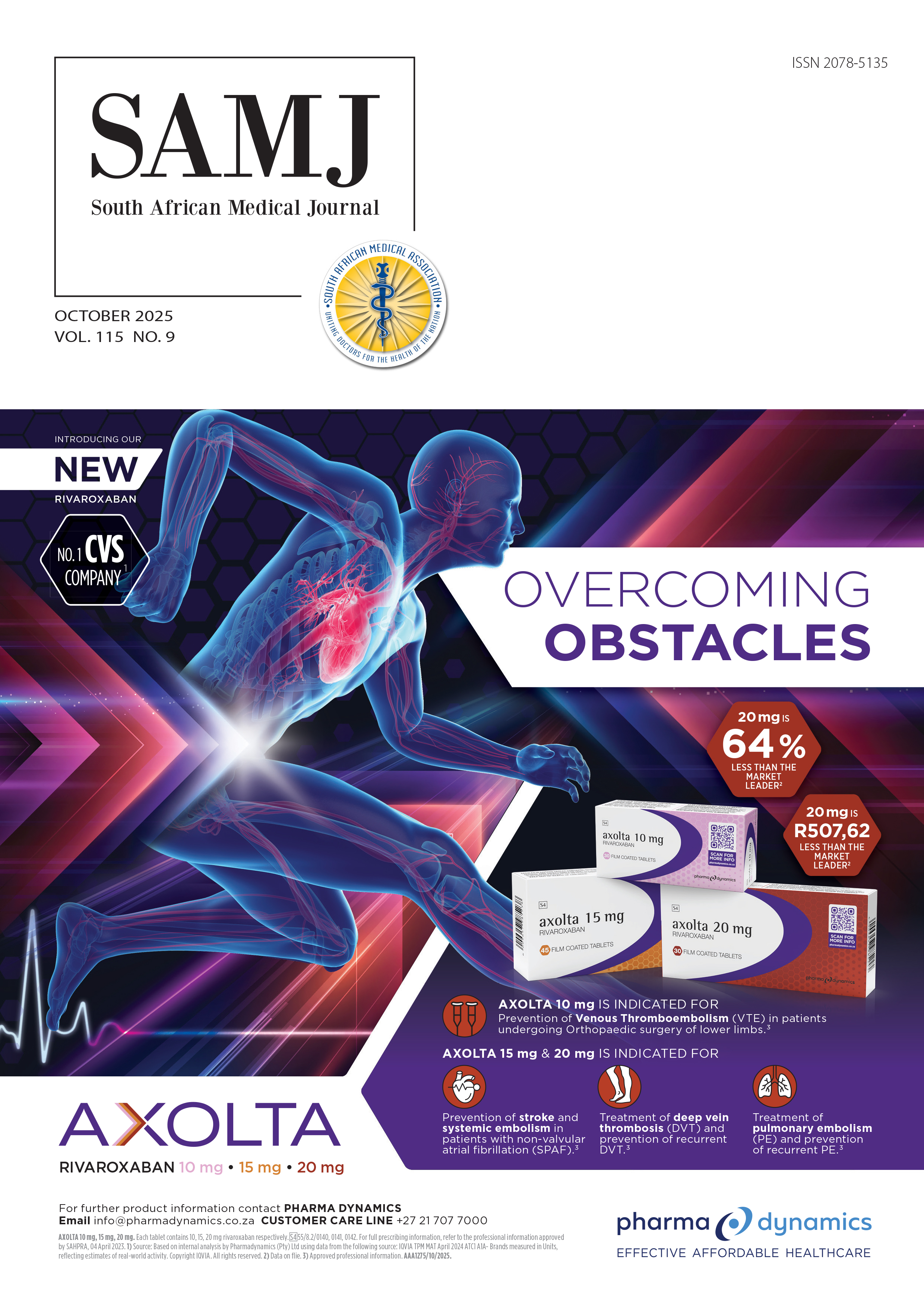Acute cellular rejection in adult liver transplant recipients in Johannesburg, South Africa
DOI:
https://doi.org/10.7196/SAMJ.2025.v115i9.3231Keywords:
Rejection, Liver, TransplantAbstract
Background. Wits Donald Gordon Medical Centre (WDGMC) in Johannesburg, South Africa, established a liver transplant programme in 2004. Acute cellular rejection (ACR) of the transplanted liver is a serious complication because of the potential for graft loss. ACR is defined as allograft dysfunction secondary to predominantly T-cell-mediated injury to the graft, and has been reported in up to 50% of liver transplants worldwide. While the advent of tacrolimus-based immunosuppression reduces the incidence of ACR in liver transplant recipients, it remains a concern.
Objectives. To review the incidence and risk factors for ACR, as well as the impact of ACR on graft survival in adult liver transplant recipients at WDGMC.
Methods. This was a retrospective review of first-time adult liver transplants performed from 1 January 2014 to 31 December 2022. Data collected included donor and recipient sociodemographic and clinical characteristics; transplant surgical procedure details; postoperative surgical complications; overall post-transplant ACR incidence rates in the first 365 days; ACR incidence stratified as early (≤90 days) and late (>91 days - <365 days); diagnosis and treatment details of biopsy-proven ACR episodes, including steroid resistance; and graft survival.
Results. Of 326 first-time adult liver transplants performed during the review period, 295 were eligible for inclusion. The post-transplant ACR incidence rates were 10.7% (early), 8.8% (late) and 20.3% overall (first 365 days). Corticosteroid resistance occurred in 19% of adult liver transplant recipients with biopsy-proven ACR. Risk factors for early ACR were younger recipient age, black ethnicity and male-donor- to-female-recipient sex discordance. A higher pre-transplant model for end-stage liver disease (MELD) score was a risk factor in late ACR. Younger recipient age, black ethnicity, female sex, acute liver failure, lower donor risk index scores and postoperative biliary complications were associated with increased risk for ACR in the first 365 days. ACR was not significantly associated with increased graft loss in this cohort.
Conclusion. While the incidence of ACR was low in this cohort, identification of ACR risk factors and presence of steroid-resistant ACR indicate the need for personalised and context-specific immunosuppression.
References
1. Crawford R, Loveland J, Gaylard P, et al. A retrospective analysis of outcomes and complications of living- and deceased-donor split-liver transplantation in Johannesburg, South Africa. S Afr Med J 2024;114(3b):e1366. https://doi.org/10.7196/SAMJ.2024.v114i3b.1366
2. Wessels EU, Loveland J, Maher H, et al. ABO-incompatible liver transplantation – exploring utilitarian solutions to restricted access and organ shortages: A single-centre experience from Johannesburg, South Africa. S Afr Med J 2024;114(3b):e1211. https://doi.org/10.7196/SAMJ.2024.v114i3b.1211
3. Kamali K, Schmelzle M, Kamali C, et al. Sensing acute cellular rejection in liver transplant patients using liver-derived extracellular particles: A prospective, observational study. Front Immunol 2021;12:647900. https://doi.org/10.3389/fimmu.2021.647900
4. Dehghani SM, Shahramian I, Afshari M, et al. Acute hepatic allograft rejection in pediatric recipients: Independent factors. Int J Organ Transplant Med 2017;8(4):203-206.
5. Song E, Fabian J, Boshoff PE, et al. Adult liver transplantation in Johannesburg, South Africa (2004 - 2016): Balancing good outcomes, constrained resources and limited donors. S Afr Med J 2018;108(11):929-936. http://doi.org/10.7196/samj.2018.v108i11.13286
6. Kinandu K, Beeton A, Beretta M, et al. The paediatric liver transplant experience in Johannesburg, South Africa: A broad overview and update. S Afr Med J 2024;114(3b):e1190. https://doi.org/10.7196/ SAMJ.2024.v114i3b.1190
7. Strong JK, Gaylard P, Maher H, Botha J. Acute cellular rejection in paediatric liver transplants: Does a living donor ameliorate the risk of rejection in our patients? A retrospective review at Wits Donald Gordon Medical Centre, South Africa. Wits J Clin Med 2019;1(3):101-108.
8. Aufhauser DD Jr, Stalter L, Marka N, et al. Detrimental impact of early biopsy-proven rejection in liver transplantation. Clin Transplant 2024;38(1):e15206. https://doi.org/10.1111/ctr.15206
9. Choudhary NS, Saigal S, Bansal RK, et al. Acute and chronic rejection after liver transplantation: What a clinician needs to know. J Clin Exp Hepatol 2017;7(4):358-366. https://doi.org/10.1016/j. jceh.2017.10.003
10. Batts KP. Acute and chronic hepatic allograft rejection: Pathology and classification. Liver Transpl Surg 1999;5(4 Suppl 1):S21-S29. https://doi.org/10.1053/JTLS005s00021
11. Sageshima J, Fuchinoue S, Hashimoto E, et al. Histopathology of hepatic allograft rejection after living- related liver transplantation. Transplant Proc 1998;30(7):3214-3215. https://doi.org/10.1016/s0041- 1345(98)01000-8
12. Demetris AJ, Bellamy C, Hübscher SG, et al. Comprehensive update of the Banff Working Group on Liver Allograft Pathology: Introduction of antibody-mediated rejection. Am J Transplant 2016;16(10):2816- 2835. https://doi.org/10.1111/ajt.13909
13. Ronca V, Wootton G, Milani C, Cain O. The immunological basis of liver allograft rejection. Front Immunol 2020;11:2155. https://doi.org/10.3389/fimmu.2020.02155
14. Demetris AJ, Zeevi A, O’Leary JG. ABO-compatible liver allograft antibody-mediated rejection: An update. Curr Opin Organ Transplant 2015;20(3):314-324. https://doi.org/10.1097/MOT.0000000000000194
15. Lee BT, Fiel MI, Schiano TD. Antibody-mediated rejection of the liver allograft: An update and a clinico- pathological perspective. J Hepatol 2021;75(5):1203-1216. https://doi.org/10.1016/j.jhep.2021.07.027
16. Yokoyama M, Imai D, Wolfe S, et al. Transplant immunology in liver transplant, rejection, and
tolerance. Livers 2024;4(3):420-434. https://doi.org/10.3390/livers4030031
17. Badwei N. Hepatic allograft rejection after liver transplantation: Clinicopathological debates! iLIVER
2023;2(2):116-121. https://doi.org/10.1016/j.iliver.2023.05.003
18. Kahn D, Gavaler JS, Makowka L, van Thiel DH. Gender of donor influences outcome after orthotopic
liver transplantation in adults. Dig Dis Sci 1993;38(8):1485-1488. https://doi.org/10.1007/BF01308608
19. Dogan N, Hüsing-Kabar A, Schmidt HH, et al. Acute allograft rejection in liver transplant recipients: Incidence, risk factors, treatment success, and impact on graft failure. J Int Med Res 2018;46(9):3979-
3990. https://doi.org/10.1177/0300060518785543
20. Feng S, Goodrich NP, Bragg-Gresham JL, et al. Characteristics associated with liver graft failure: The concept of a donor risk index. Am J Transplant 2006;6(4):783-790. https://doi.org/10.1111/j.1600- 6143.2006.01242.x. Erratum in: Am J Transplant 2018;18(12):3085. https://doi.org/10.1111/ajt.15155
21. Shepherd RW, Turmelle Y, Nadler M, et al. Risk factors for rejection and infection in pediatric liver transplantation. Am J Transplant 2008;8(2):396-403. https://doi.org/10.1111/j.1600-6143.2007.02068.x 22. Lai Q, Giovanardi F, Melandro F, et al. Donor-to-recipient gender match in liver transplantation: A systematic review and meta-analysis. World J Gastroenterol 2018;24(20):2203-2210. https://doi.
org/10.3748/wjg.v24.i20.2203
23. Magyar CTJ, Gretener CP, Baldi P, et al. Recipient donor sex combinations in solid organ transplantation and impact on clinical outcome: A scoping review. Clin Transplant 2024;38(5):e15312. https://doi.org/10.1111/ctr.15312
24. Del Bello A, Congy-Jolivet N, Danjoux M, et al. High tacrolimus intra-patient variability is associated with graft rejection, and de novo donor-specific antibodies occurrence after liver transplantation. World J Gastroenterol 2018;24(16):1795-1802. https://doi.org/10.3748/wjg.v24.i16.1795
25. Thongprayoon C, Hansrivijit P, Kovvuru K, et al. Impacts of high intra- and inter-individual variability in tacrolimus pharmacokinetics and fast tacrolimus metabolism on outcomes of solid organ transplant recipients. J Clin Med 2020;9(7):2193. https://doi.org/10.3390/jcm9072193
26. Wheeler C, Masimirembwa C, Mthembu B, et al. Impact of donor CYP3A5 genotype on pharmacokinetics of tacrolimus in South African paediatric liver transplant patients. S Afr Med J 2024;114(3b):e1367. https://doi.org/10.7196/SAMJ.2024.v114i3b.1367
27. Siddiqui NM, Hari K, Bobat B, Parbhoo D, et al. Outcome of liver transplantation for autoimmune hepatitis in South Africa. Ann Clin Gastroenterol Hepatol 2022;6:44-50. https://doi.org/10.29328/ journal.acgh.1001038
28. Thangarajah D, O’Meara M, Dhawan A. Management of acute rejection in paediatric liver transplantation. Paediatr Drugs 2013;15(6):459-471. https://doi.org/10.1007/s40272-013-0034-4
29. Aydogan C, Sevmis S, Aktas S, Karakayali H, Demirhan B, Haberal M. Steroid-resistant acute
rejections after liver transplant. Exp Clin Transplant 2010;8(2):172-177.
30. Lee JG, Lee J, Lee JJ, et al. Efficacy of rabbit anti-thymocyte globulin for steroid-resistant acute rejection
after liver transplantation. Medicine 2016;95(23):e3711. https://doi.org/10.1097/MD.0000000000003711.
Erratum in: Medicine 2016;95(28):e0916. https://doi.org/10.1097/01.md.0000489580.04709.16
31. Lee TY, Choi HJ, Seo CH, et al. Steroid-resistant rejection in liver transplant: A single-center study for risk factor and second-line treatment. Transplant Proc 2022;54(2):443-449. https://doi.org/10.1016/j.
transproceed.2021.10.019
32. Harris PA, Taylor R, Thielke R, et al. Research electronic data capture (REDCap) – a metadata-driven methodology and workflow process for providing translational research informatics support. J Biomed Inform 2009;42:377-381. https://doi.org/10.1016/j.jbi.2008.08.010
33. Harris PA, Taylor R, Minor BL, et al. The REDCap consortium: Building an international community of software platform partners. J Biomed Inform 2019;95:103208. https://doi.org/10.1016/j.jbi.2019.103208
34. Sheikh A, Chau KY, Evans HM. Histological findings in protocol biopsies following pediatric liver transplant: Low incidence of abnormalities at 5 years. Pediatr Transplant 2018;22(5):e13212. https:// doi.org/10.1111/petr.13212
35. Pan F, Cao S, Li XL, et al. The model for end-stage liver disease score and the follow-up period can cause the shift of circulating lymphocyte subsets in liver transplant recipients. Front Med 2022;8:779443. https://doi.org/10.3389/fmed.2021.779443
36. Jia J, Nie Y, Geng L et al. Identification of HO-1 as a novel biomarker for graft acute cellular rejection and prognosis prediction after liver transplantation. Ann Transl Med 2020;8(5):221. https://doi. org/10.21037/atm.2020.01.59
37. Maluf DG, Stravitz RT, Cotterell AH, et al. Adult living donor versus deceased donor liver transplantation: A 6-year single center experience. Am J Transplant 2005;5(1):149-156. https://doi. org/10.1111/j.1600-6143.2004.00654.x
38. Selzner M, Kashfi A, Cattral MS, et al. Live donor liver transplantation in high MELD score recipients. Ann Surg 2010;251(1):153-157. https://doi.org/10.1097/SLA.0b013e3181bc9c6a
Downloads
Published
Issue
Section
License
Copyright (c) 2025 K Kinandu, B Bobat, R Crawford, M Eagar, P Gaylard, Z Khan, W Kuka, V Lala, A Mahomed, D Mokgoko, D Parbhoo, S Rambarran, F van der Schyff, M Seabi, S Sobnach, B Ströbele, J Wing, J Loveland, J Fabian

This work is licensed under a Creative Commons Attribution-NonCommercial 4.0 International License.
Licensing Information
The SAMJ is published under an Attribution-Non Commercial International Creative Commons Attribution (CC-BY-NC 4.0) License. Under this license, authors agree to make articles available to users, without permission or fees, for any lawful, non-commercial purpose. Users may read, copy, or re-use published content as long as the author and original place of publication are properly cited.
Exceptions to this license model is allowed for UKRI and research funded by organisations requiring that research be published open-access without embargo, under a CC-BY licence. As per the journals archiving policy, authors are permitted to self-archive the author-accepted manuscript (AAM) in a repository.
Publishing Rights
Authors grant the Publisher the exclusive right to publish, display, reproduce and/or distribute the Work in print and electronic format and in any medium known or hereafter developed, including for commercial use. The Author also agrees that the Publisher may retain in print or electronic format more than one copy of the Work for the purpose of preservation, security and back-up.





